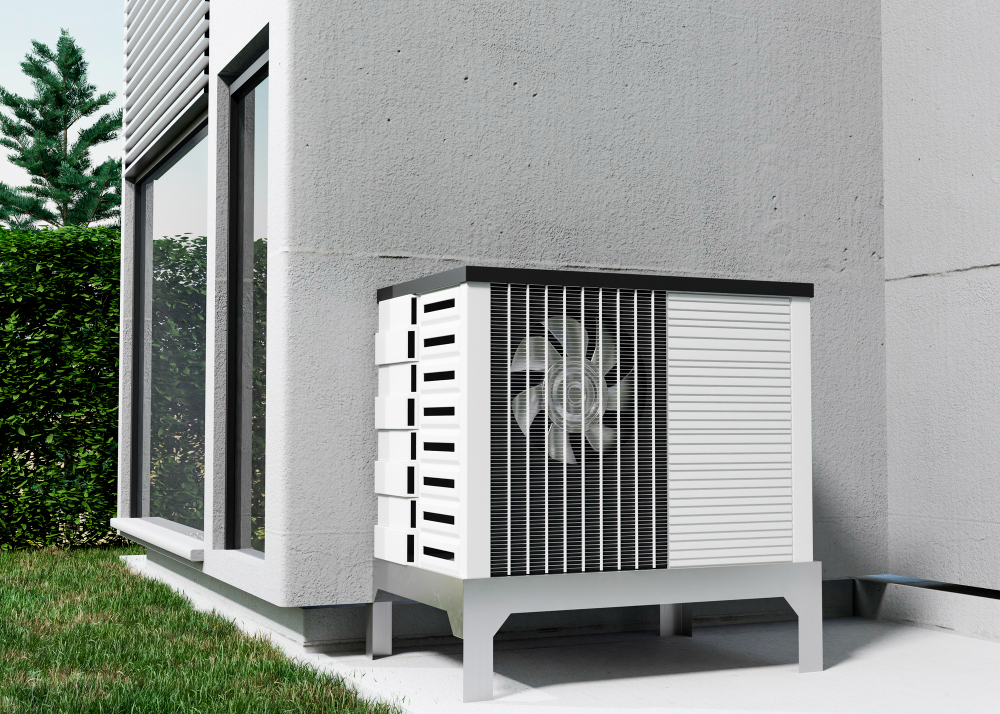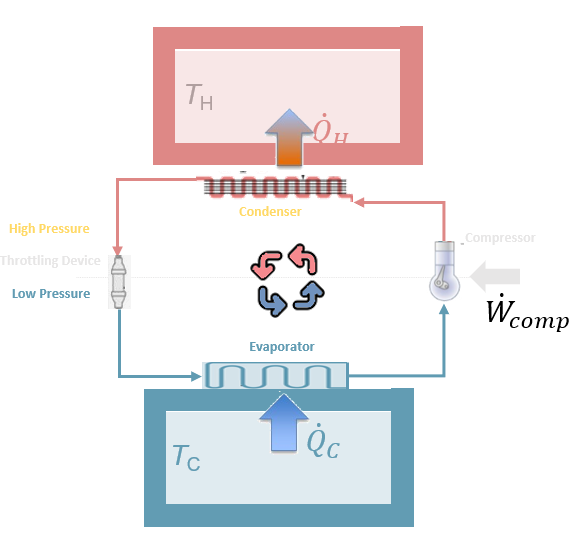4.4.2 Lecture notes Heat Pumps
Course subject(s)
4. Intelligent Control and Integration of Heating in the Energy Systems

This image is from freepik
This lecture introduces the concept of heat pumps and their role in the energy transition. The following topics will be covered:
- The working principle of heat pumps
- The performance of heat pumps
- The role of heat pumps in the energy transition
The working principle of heat pumps
Heat pumps have a similar working principle as refrigerators. A refrigerator works on Vapour-Compression cycle and its basic working principle can be explained with the figure below. The part of the refrigerator that needs to be cooled is the bottom part denoted with blue and it has a temperature of TC. The room to which the heat is released is shown in red and it has a temperature of TH. The refrigerant (the liquid which is used for cooling) goes around the loop anti-clockwise. It takes up heat from the cold reservoir, which can be named QH. This is then compressed by the compressor, which does electrical work (Wcomp), where the temperature and pressure of the refrigerant is increased. The heated refrigerant releases heat to the hot reservoir, which can be labelled as QH. This cycle is repeated such that heat is extracted from the cold reservoir and added to the hot reservoir.

By using the first limit of thermodynamics, the following relation can be obtained:

The coefficient performance of the refrigerator (COP) can be defined as the ratio of the useful delivered heat compared with the electrical work, which can be written as:

In practice, A heat pump is more complex than described above. A better representation of a refrigerator is shown in the figure below. Additional electrical work is required on the hot side (Wpump-H) and on the cold side (Wpump-C).

In this situation the COP can be written with the following expression:

If all the processes are reversible, then it can be derived that the COP of the heat pump can be written as the following equation:
The performance of a heat pump
The actual COP of the heat pump is more complex, and it typically is lower than the COP of the reversible heat pump COP. The COP depends largely on the temperature of the heat source and the sink temperature. This would mean that if Aquifers or geothermal heat sources can be used, high values for the COP can be obtained. The performance of the heat pump by using different heat sources, can be shown in the figure below.
The heat pumps that are currently available at the market have a COP of around 2.4. Their heating capacity is around 150 kW, and the sink temperature is around 40 degrees Celsius. The cycle of heat pumps can be improved by investing more in the heat exchangers and having larger areas. This would increase the COP to around 2.8. However, the specific cost (the price per MWh of energy) would remain the same. Furthermore, by increasing the efficiency of the compressors, the COP can increase even further to 3.1.
The role of heat pumps in the energy transition
The role of heat pumps for the energy transition can be understood by looking at the energy balance of a household for a certain year. Normally, the demand for gas is higher in the winter than in the summer. When heat pumps are used, they will replace the gas system. As shown before, different types of heat sources are possible:
- If an air source heat pump is used, a lot of electricity is required, since this type of heat pump has a low COP. Therefore, the total electricity import will be more than 4000 kWh per year.
- If a groundwater source heat pump is used, the electricity import will decrease to 2700 kWh per year, since it has a better COP. However, using this technology for all individual houses is not economically feasible.
- If Aquifers are used, which can only be used together with neighbouring houses, the electricity import will be around 1500 kWh per year.
- If low temperature geothermal heat sources are used, the net electricity import will be around 57 kWh per year, since they have a high COP.
For each situation, the electricity demand in the winter will be larger than the electricity demand in the summer. However, the excess thermal energy in the summer can be stored to cover for the heating demand in the winter.
Conclusion
This lecture introduced heat pumps. First the working principle of a heat pump and refrigerator was discussed, and the performances were analysed. It was also shown that different sources as heat source affect the performance of a heat pump. Finally, it was shown how heat pumps can replace the gas systems that are used today.

Technology of Intelligent and Integrated Energy Systems by TU Delft OpenCourseWare is licensed under a Creative Commons Attribution-NonCommercial-ShareAlike 4.0 International License.
Based on a work at https://online-learning.tudelft.nl/courses/technology-of-intelligent-and-integrated-energy-systems/




